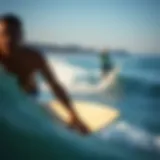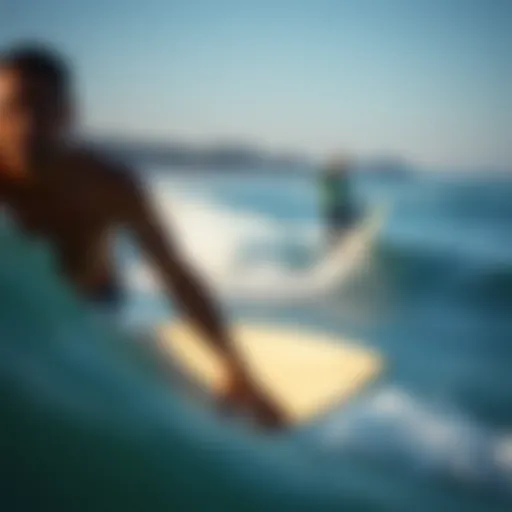An Exploration of Wings Surfing: A New Dimension in Water Sports
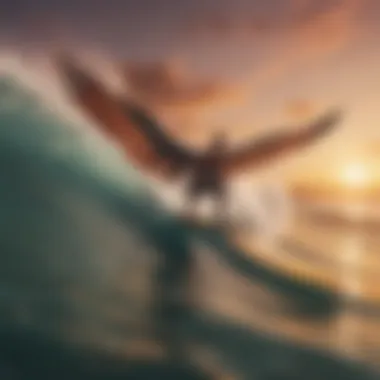

Intro
In recent years, wings surfing has emerged as a notable addition to the realm of water sports, captivating a range of enthusiasts from casual beachgoers to serious athletes. This innovative blend of traditional surfing and wind sports offers an exhilarating experience, diving into an entirely new dimension of water activity. Wings surfing allows individuals to harness the wind while standing on a surfboard, creating a unique connection with the water and air around them.
The purpose of this article is to thoroughly explore wings surfing's origins, its techniques, and the equipment that distinguishes it from other water sports. As wings surfing gains momentum, it's essential to provide insights into the skills required to master this activity, from basic frameworks for novices to advanced maneuvers for seasoned practitioners. We’ll also delve into the equipment options available, ensuring every surfer has the right tools to ride the waves effectively.
Whether you are an experienced surfer looking for a new challenge or a beginner yearning to catch your first waves with a wing, there’s something for everyone in this exploration of wings surfing. As you read on, expect practical tips, step-by-step guides, and discussions on the ecological impact of this sport as it intertwines with local marine environments. Stay with us as we unravel the nuances of this exhilarating new trend.
Prelude to Wings Surfing
Wings surfing, an innovative blend of traditional surfing and wind sports, is making significant waves among aquatic enthusiasts. This practice invites not just thrill-seekers, but also those looking to expand their skills in water activities. Learning about wings surfing is essential, as it opens a door to a unique experience that brings together the exhilaration of gliding over water with the elemental power of the wind.
Through its distinct techniques and equipment, this sport offers various benefits, namely a chance to enhance one’s physical fitness, agility, and connection to the elements. For the uninitiated, the world of wings surfing may seem daunting, but understanding its foundations and nuances can significantly boost one’s confidence and enjoyment.
As we dive deeper into this article, we'll uncover essential perspectives on wings surfing—what it is, the reasons for its rapid acceptance among water sports lovers, and the fundamental skills required to thrive both as a beginner and an experienced surfer. With a focus on practical tips and critical safety measures, our exploration will prepare anyone interested in catching the wind and riding the waves.
What is Wings Surfing?
Wings surfing is a relatively new water sport that combines elements from several disciplines, namely surfing, windsurfing, and kitesurfing. It involves using a handheld wing to harness the wind's power while riding on a board across the water's surface. The wing acts like a sail, allowing surfers to glide effortlessly over the water, whether in flat conditions or on waves. It's an exciting shift from the more conventional forms of board sports, as it introduces a unique dynamic with respect to balance, control, and navigation.
At its core, wings surfing provides a sensation of freedom—gliding swiftly as one becomes attuned to the wind's direction and force. This connection is not just about the thrill of riding; it requires a certain level of awareness and adaptability. For enthusiasts, wings surfing is not merely an activity but an exhilarating art form that captivates the senses.
The Rise of Wings Surfing
In the past few years, wings surfing has seen a remarkable surge in popularity. This growth can be attributed to various factors that make it appealing to a broad audience. For starters, the simplicity in equipment design stands out; wings are typically lighter and more accessible than traditional kitesurfing gear. This lower barrier to entry attracts novices who might be intimidated by the complexity of other wind sports.
Social media has played a big role too. With the rise of platforms such as Instagram and TikTok, stunning visuals of wings surfers effortlessly gliding over the water have captivated the public's imagination. Witnessing the vibrant images and videos trending on these platforms inspires outdoor enthusiasts to try their hand at this novel sport, as it looks as fun as it is visually striking.
Moreover, established water sports communities worldwide are integrating wings surfing into their offerings, creating workshops and events dedicated to teaching the essentials of this practice. This growing recognition aligns well with the ongoing trend of sustainable and minimalist lifestyles, where individuals are looking for experiences that connect them directly with the environment.
Given these compelling factors, wings surfing is likely to continue its upward trajectory as more people become aware of the sport's joys and community. As more players enter the field, the techniques and gear will evolve—potentially leading to even more exciting innovations in the sport.
Core Equipment and Gear
When venturing into wings surfing, understanding the core equipment and gear is crucial for both performance and safety. Each piece of gear plays a unique role, acting as the backbone of the entire experience. Whether you’re new to the arena or a seasoned pro, savvy knowledge about the gear can dramatically enhance your time on the water.
The Wing: A Closer Look
The wing is the heart of this water sport, central to how you catch wind and glide across the surface. Unlike traditional kites, the wings are handheld and offer a direct connection between the rider and the wind. Here are a few vital elements to keep in mind:
- Design: Wings come in various designs—some prioritize high lift while others focus on speed. Opt for a size that complements your skills and the wind conditions you expect to encounter.
- Material: Lightweight materials can make a significant difference in performance. Durable fabrics resist wear and tear, but ensure they maintain a good weight-to-strength ratio to not hinder movement.
- Inflation System: Look for an easy inflation mechanism. Quick inflation and deflation can save valuable time, especially when conditions shift.
Consider how each aspect of the wing aligns with your personal style and skill level.
Selecting the Right Board
Finding the perfect board is like searching for a needle in a haystack. The right board can elevate your experience, while the wrong one can leave you floundering. Here’s what to assess in your selection:
- Size: Bigger boards generally offer more stability, which is advantageous for learners. Conversely, shorter boards offer greater maneuverability for those looking to push their limits.
- Width: A wider board is more stable, especially for beginners or anyone battling rough conditions. Width contributes to how the board floats on the water, thus influencing ease of paddle and takeoff.
- Type: Boards differ in style, such as inflatable or solid. Inflatable boards have become more popular due to portability and safety, while solid boards may offer better performance under specific wind conditions.
In summary, gauge your choices against anticipated usage and any specific features that may enhance your performance.
Safety Equipment Essentials
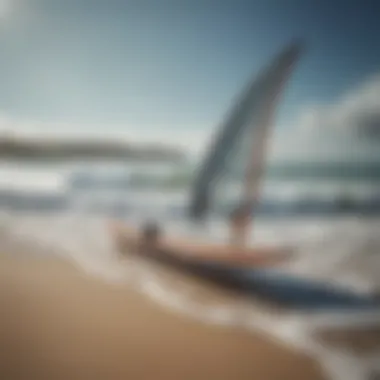

Safety in wings surfing is paramount. The thrill should never outweigh your well-being. Below are essential safety gear recommendations:
- Impact Vest: Wearing a proper impact vest can protect your torso during falls. Many modern vests are both comfortable and lightweight, allowing for flexibility without impeding movement.
- Helmet: This may save your noggin if you take an unplanned tumble. Ensure a snug fit for both comfort and protection.
- Leash: A leash ties you to your board, minimizing the risk of losing it in the water—crucial for safety and efficiency when you're trying to get back into the action.
"Preparation is key in wings surfing; without the right gear, you won't just compromise your performance but also your safety."
- Buoyancy Aid: Knowing you can safely float in case of an emergency can help keep your mind at ease while you ride the waves.
Choosing your safety gear wisely sets the tone for enjoyable and secure wings surfing adventures.
Fundamental Techniques for Beginners
Wings surfing, a thrilling sport merging the best aspects of surfing and wind sports, demands a solid foundation for beginners. Grasping the fundamental techniques not only builds confidence but also enhances overall performance. Whether it's getting the stance right or mastering how to launch, every component plays a significant role in executing maneuvers smoothly on the water. Beginners often grapple with initial challenges, but focusing on core techniques can expedite their learning curve. The key here is that understanding the basics opens up a world of possibilities on the waves.
Getting Started: Basic Stance and Balance
To kick off, having the correct stance is paramount. A beginner should stand with feet shoulder-width apart, providing a stable base. This allows the center of gravity to be evenly distributed, improving balance significantly. Knees should be slightly bent, almost as if one is preparing to catch a football or get ready for a sprint.
- Foot Positioning: The back foot should typically be positioned near the tail of the board, while the front foot sits between the midpoint and a quarter of the way to the nose. This setup helps to direct the board effectively.
- Upper Body: Keep your arms relaxed and extended slightly to either side for balance. Think of it as being on a tightrope—you wouldn’t want to topple over.
- Gaze: It is crucial to look where you want to go. Your body will naturally follow your gaze, thus directing your movements and aiding in maintaining balance.
These minor adjustments might seem trivial, but they can make a world of difference. "Balance is not a skill; it's a habit, and it begins here." Knowing how to stand properly in wings surfing sets the stage for a successful ride.
Mastering the Launch
Once the stance is nailed down, the next significant hurdle is mastering the launch. This is where many beginners falter, leading to frustration. Getting this step right can feel like a rite of passage.
To launch effectively:
- Position the Wing: Holding the wing overhead with arms straight, one should stand slightly angled into the wind. This position creates instant lift.
- Engage the Board: As the wind catches the wing, lean slightly forward to gain initial speed. The goal is to have the board glide effortlessly on the water.
- Timing: Timing is everything. A smooth motion, where the wing transitions from positioned to fully launched, is crucial. Avoid jerky movements as they can lead to losing balance.
With practice, launching will become second nature. Each successful attempt enhances muscle memory while building the athlete's confidence.
Navigating the Water: Tips for Stability and Control
Once afloat, maintaining stability and control is key. Navigating the water with finesse is essential for both safety and enjoyment.
- Weight Distribution: Shifting weight to the back foot can help control speed, especially when aiming for sharper turns. Beginners often feel inclined to lean forward, but this can unintentionally increase speed and reduce maneuverability.
- Steering with the Wing: The wing acts like a rudder. By adjusting the angle at which it's held, you can make sharp turns or glide straight. Lowering the wing in the direction of the desired turn can be particularly effective.
- Practice Stopping: Learning to stop is as imperative as moving forward. To slow down, pull the wing slightly back towards you while leaning back. This not only gives control but also prevents potential wipeouts.
By focusing on these maneuvers, beginners can enjoy the freedom that comes with wings surfing while minimizing the chance of accidents or falls.
The beauty of wings surfing lies in its adaptability to various open water conditions and the excitement awaits at every wave. This journey into wings surfing may be challenging at the start, but once grasped, offers unmatched exhilaration.
For in-depth discussions and additional tips on wings surfing, consider visiting resources like Wikipedia, Britannica, or participating in community forums on Reddit and Facebook.
By putting these techniques into practice, beginners can pave the way for a fulfilling experience in wings surfing, ensuring a safe and engaging ride.
Advanced Techniques for Experienced Surfers
As surfers grow more comfortable with wings surfing, they seek to elevate their game. Advanced techniques become essential, bringing not only excitement but also improvements in performance. Mastering these capabilities can transform a casual ride into an exhilarating experience. Whether you're carving through waves or busting out aerial tricks, these advanced skills can open new dimensions in your journey on the water.
Carving and Turning: Enhancing Performance
When it comes to carving and turning on a wing, precision is key. This technique allows surfers to maneuver their boards smoothly, maintaining control while navigating waves. A strong carve can meld speed with fluidity, amplifying overall performance.
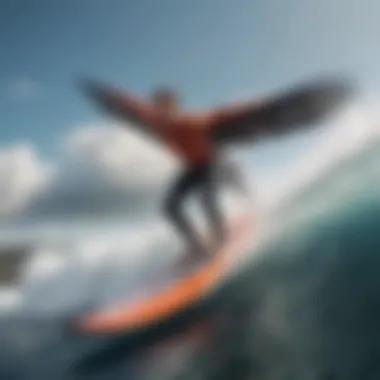

Key Elements of Carving:
- Body Position: Keep your center of gravity low, this helps in maintaining balance while turning.
- Foot Pressure: Shift your weight subtly towards your toes or heels, depending on the direction you want to go.
- Wing Control: Let the wing guide you. The more you learn to manage its angle and force, the better you'll be at executing sharp turns.
"Mastering the carve not only enhances your stability but also allows for quicker transitions between waves."
Carving effectively can help you catch waves better and make the most of your time on the water. This maneuver is vital for any surfer aiming for progression in their wings surfing skills.
Jumping and Tricks
Once you’ve got a solid grip on carving, you might feel the urge to take to the air. This is where jumping and tricks come into play. A well-timed jump can feel like you’re defying gravity. As you execute tricks, it’s crucial to keep the wing and board dynamics in mind.
Things to Consider:
- Timing: Wait for the right moment when the wind and water conditions align. This is essential for a successful takeoff.
- Landing: Aim for a smooth touchdown; align your body and board properly to absorb the impact without losing balance.
- Practice: Start with small hops and work your way to higher jumps and rotations.
Tricks like rotations, flips, and grabs not only enhance your style but also show mastery of the sport. Getting these jumps right can significantly boost your confidence and thrill.
Using Wind and Wave Patterns
Understanding and utilizing wind and wave patterns is crucial for advanced wings surfing. The interplay between these elements can make or break your session on the water. Experienced surfers need to be adept at reading conditions to maximize their ride.
Tips for Understanding Patterns:
- Wind Direction: Pay attention to how the wind shifts—cross-shore winds can be your best friend, providing lift while you maneuver.
- Wave Conditions: Learn how swell shapes up; this knowledge helps you hit the wave at the right moment to gain speed and height.
- Seasonal Changes: Different times of the year can lead to varying conditions. Be ready to adapt your techniques accordingly.
Surfers who excel in understanding their environment can navigate like seasoned pros, allowing for thrilling experiences even in varied conditions.
Incorporating these advanced techniques into your wings surfing practice not only hones your abilities but also deepens your connection to the sport. As you grow in skill, you’ll find yourself continuously improving, unlocking new facets of surfing that once felt out of reach.
Navigating Environmental Conditions
In the world of wings surfing, understanding the elements at play is as crucial as mastering the techniques of riding the waves. The environment, especially wind, tides, and currents, can make or break your experience on the water. This section delves into navigating environmental conditions, underscoring the significant role they play in optimizing your performance and safety.
Understanding Wind Patterns
Wind patterns are the lifeblood of wings surfing. The dynamics of how the wind blows can dictate your control and speed. Winds can originate from various sources: local seabreezes, storm fronts, or even global patterns like the trade winds. It’s essential for surfers to learn how to read these patterns to adapt effectively.
When setting out, try to observe the wind's direction and velocity. A gusty sea breeze might seem inviting, but if you're not careful, it can turn into a wild ride. Here are a few key insights into wind patterns:
- Consistency: A steady wind is preferable for beginners. Irregular winds could lead to sudden dips in speed or unexpected shifts in direction.
- Speed: A recommended range is between 10 to 20 knots for enjoyable surfing. Too much wind could toss you around, while too little might leave you stranded.
- Local Effects: Each area has its own unique wind behaviors, influenced by terrain and temperature. Familiarity with your surfing locale can provide an edge.
"In wings surfing, the wind is the dance partner—understanding its moves makes for a beautiful performance."
Tides and Currents: What to Watch For
Tides, a product of the moon’s gravitational pull, greatly influence water sports. The timing of your session relative to high and low tides can have profound effects on your surfing experience. High tides may offer deeper water and less wave interference, while low tides can expose sandbars or reefs, producing more challenging surf but also greater risks.
Here are some considerations regarding tides and currents:
- Current Awareness: Know the local currents and how they behave during different tides. Some areas might have swift currents that can swiftly carry you away if you’re not prepared.
- Timing: Always check tide charts before heading out. They indicate when to expect high or low water, which can be critical for safety and performance.
- Spot Selection: Some locations might be better at specific tides. Engage with local surfers or visit forums like reddit.com to gather insights about the best spots during varying tidal conditions.
Safety Precautions in Varied Conditions
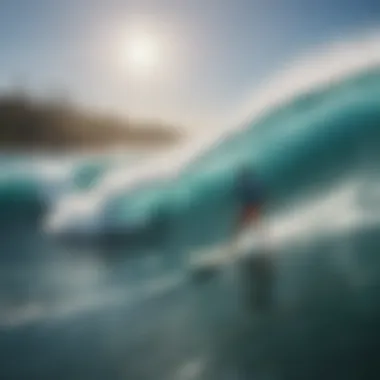

Staying safe while wings surfing requires a proactive approach to environmental awareness. Having an understanding of the conditions helps mitigate risks significantly. Here are some safety precautions to take:
- Research the Area: Each surfing spot has its own set of hazards, be they shallow reefs, strong currents, or dangerous marine life. Make sure to know what you’re dealing with.
- Wear Proper Gear: Invest in a good flotation device, especially if you're a beginner. Each coastal region might also have rules about the use of wetsuits or other protective gear.
- Plan for Changes: Weather conditions can shift rapidly. Always have a plan and an exit strategy in case the skies turn gray.
- Buddy System: Whenever possible, surf with a companion. In case things go awry, having someone else there can make all the difference.
- Listen to Your Gut: If something feels off—whether it’s the wind, the waves, or your own comfort—better to err on the side of caution.
By focusing on the environmental conditions, wings surfers can not only enhance their skills but also ensure their safety while exploring this exhilarating sport.
Cultural Impact of Wings Surfing
The phenomenon of wings surfing transcends mere recreational activity; it embodies a cultural shift that reflects the evolving landscape of water sports. As this dynamic sport gathers momentum, its influence ripples through communities, environmental awareness, and the broader surf culture. Understanding the cultural impact of wings surfing is essential for appreciating its significance in the tapestry of modern outdoor adventures.
Community and Social Aspects
At the heart of wings surfing lies a vibrant community that thrives on camaraderie, knowledge sharing, and mutual encouragement. The enthusiasm evident among enthusiasts fosters a sense of belonging, often drawing individuals together beyond regional lines.
- Social Media Connectivity: Platforms like Facebook and Reddit host numerous groups and forums where surfers exchange tips, showcase their skills, and share adventures. This sense of connectivity fosters inclusive dialogue around techniques, conditions, and gear.
- Local Meetups: Many clubs or groups organize social events, rallies, or beach clean-ups which are great not only for skill enhancement but for building friendships. These gatherings showcase the laid-back nature of the surf culture, effectively cementing wings surfing's identity within it.
- Competitions & Events: Promotional competitions add a layer of excitement to the sport, inspiring both beginners and seasoned athletes to push their limits. These events help cultivate a healthy competitive spirit, an aspect that fosters growth and innovation, keeping the community engaged.
Environmental Considerations
The surge in wings surfing coincides with increasing awareness of environmental issues affecting our oceans and coastlines. This sport, while thrilling, encourages participants to respect and protect marine ecosystems, directly influencing its cultural context.
- Promoting Sustainable Practices: Many wings surfers adopt eco-friendly habits. For instance, using biodegradable materials for gear and minimizing plastic use goes hand-in-hand with the growing emphasis on sustainability in sports.
- Educational Initiatives: Collaborative efforts with environmental organizations underline the importance of ocean health. Many wings surf clubs launch initiatives aimed at educating surfers about marine life, pollution, and responsible practices.
- Marine Conservation Engagement: Increased participation in local conservation projects shows promising engagement of the wings surfing community. By involving themselves in beach clean-ups, fostering a culture of environmental stewardship becomes part of the sport's DNA.
"Wings surfing isn't just a sport; it’s an expression of our commitment to preserving the magic of the ocean."
The Future of Wings Surfing and Surf Culture
As wings surfing carves its niche, one can foresee an evolving relationship between this sport and traditional surf culture. The adaptability of wings surfers—who blend elements of wind sports with surfing—heralds an intriguing future.
- Integration of Technology: Technological advancement could revolutionize wings surfing. From improved wing designs to smart gear equipped with tracking devices, innovation promises to enhance the experience.
- Cross-genre Influence: The burgeoning interest in this fusion of wind sports and traditional surfing may catalyze innovations in storytelling, art, and fashion, as new narratives emerge about shared experiences.
- Inclusivity and Accessibility: Wings surfing continues to break barriers, providing options for varied skill levels. This accessibility opens doors for a wider audience, thereby ensuring its cultural relevance continues to expand.
As the waves beckon and the wind calls, wings surfing offers not only an escape but also a canvas for community, environmental stewardship, and cultural evolution, painting an exciting picture for the future.
In summary, the cultural impact of wings surfing encapsulates a rich tapestry of community bonding, environmental mindfulness, and an ever-evolving surf culture that is bound to shape not just how we experience water sports but also how we regard our environment.
The End and Future Directions
Wings surfing has carved out a niche in the world of water sports, showcasing not only the thrilling adrenaline rush that enthusiasts crave but also presenting fresh avenues for engagement with the environment. As we bring this exploration to a close, it’s essential to reflect on the growth and evolution of this relatively new discipline, whose emergence has stirred considerable interest among surfers, travelers, and fitness aficionados alike.
Reflecting on the Growth of Wings Surfing
To understand the impact of wings surfing, one must consider its rapid ascent in popularity since its inception. The fusion of surfing and wind sports is not merely a trend but a revolution. Riders employ specially designed wings to harness wind power, navigating across the water in a dance of skill and technique. The number of participants in this activity has swelled, with communities forming at beaches and surf spots around the globe.
This growth has been fueled by numerous factors:
- Access to Equipment: Manufacturers have ramped up production, making wings and boards more affordable and accessible.
- Social Media Influence: Platforms like Instagram and TikTok have propelled wings surfing into the limelight, as stunning visuals capture the attention of prospective surfers looking for their next adrenaline hit.
- Events and Competitions: Organized competitions are popping up, providing platforms for riders to showcase their skills and foster camaraderie among enthusiasts.
While this expansion is promising, it’s crucial to address the implications it has on local cultures and the environment. Increased foot and water traffic can lead to wear on natural habitats, necessitating a balance between fun and responsibility. Enthusiasts should consider how their actions impact local ecosystems, adopting best practices to preserve these shared playgrounds.
Call to Action for Enthusiasts
For those already enamored with wings surfing, it's time to take the next step. Engage with local communities, learn from seasoned surfers, and share your experiences with others looking to take the plunge. Whether it’s participating in a local wings surfing meetup, posting tutorials online, or simply discussing tips and tricks on platforms such as reddit.com, your involvement can make a difference.
Moreover, consider how you can contribute to making wings surfing sustainable:
- Educate Yourself: Stay informed about local wildlife and habitats where you surf.
- Practice Clean Surfing: Always clean up after sessions; avoid leaving trash at your surf spot.
- Support Eco-friendly Brands: Choose brands that prioritize sustainable materials and practices in their equipment.
As wings surfing continues to soar, the collective effort of enthusiasts can guide it towards a future that respects both sport and environment, ensuring the thrill of riding the wind lasts for generations to come.
In essence, as each rider glides across the water, they carry not only their equipment but also the responsibility of stewardship towards the ocean and its surroundings.
With bold waves to conquer and winds to ride, the horizons of wings surfing remain vast and untapped, inviting all to join in this exhilarating journey.
